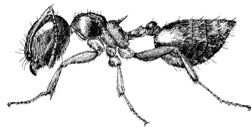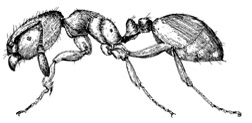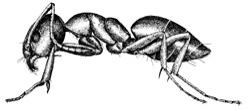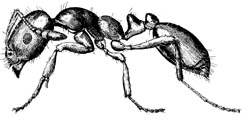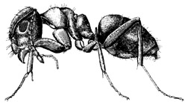Ants In and Around the Home
Ants rank number one in inquiries at our Ohio State University Extension Entomology office over all other household/structural pests. It is very important to have an accurate ant identification in order to determine the best method of control if needed. When in doubt, collect several specimens in a watertight vial, add isopropyl or 70 percent alcohol (not water), and enclose in a crush proof box. Take to your county Extension office of Ohio State University Extension or mail to the C. Wayne Ellett Plant and Pest Diagnostic Clinic, 110 Kottman Hall, 2021 Coffey Road, Columbus, Ohio 43210-1087, phone (614)292-5006. A nominal fee is charged for specimen identification. Some ants are so small and similar in appearance when viewed by the naked eye, that it takes trained specialists to tell the difference between species.
|
Common Name |
Scientific Name |
|
Carpenter Ant |
Camponotus spp. |
|
Cornfield Ant |
Lasius alienus (Foerster) |
|
Larger Yellow Ant |
Acanthomyops interjectus (Mayr.) |
|
Pharaoh Ant |
Monomorium pharaonis (Linn.) |
|
Thief Ant |
Solenopsis molesta (Say) |
|
Pavement Ant |
Tetramorium caepitum (Linn.) |
|
Little Black Ant |
Monomorium minimum (Buckley) |
|
False Honey Ant |
Prenolepis imparis (Say) |
|
Allegheny Mound Ant |
Formica exsectoides Forel |
|
Lawn Ant |
Iridomyrmex pruinosus var. analis (E. Andre) |
|
Acrobat Ant |
Cremastogaster lineolata (Say) |
|
Odorous House Ant |
Tapinoma sessile (Say) |
|
Crazy Ant |
Paratrechina longicornis (Latrielle) |
Identification
- Ant bodies appear constricted or pinched in at the waist (shaped like a figure 8), while termites do not have the waist constriction.
- Ants have elbowed antennae, while termites have straight, bead-like antennae.
- The forewings of ants are much larger than the hindwings. Termites' wings are equal in size and shape.
- Ant wings are transparent or brownish, while termite wings are milky-white or grayish and longer than the body.
- Ant wings are firmly attached, while termite wings are easily removed or shed (fall off). Differences between a winged termite and a winged ant.
Life Cycle and Habits
Ants are social insects that live in colonies or nests usually located in the soil near the house foundation, under concrete slabs, in crawlspaces, in structural wood, in the yard or garden, in trees and in other protected places. Ants have three castes, namely queens, males and workers. Queens and males are the reproductives. Workers are sterile wingless females. New ant colonies are started by a single fertilized queen that lays eggs and tends her brood (larvae and pupae) that develop into worker ants. Tending of the brood is then taken over by the worker, which may shift the brood from place to place as moisture and temperature fluctuate in the nest. When workers forage for food for the queen and her young, they often may enter houses and become a nuisance by their presence and contaminate food.
Carpenter Ant
These ants are the largest found in Ohio and rank number one in inquiries over all other ants. They are a nuisance by their presence when found in parts of the home such as the kitchen, bathroom, living room and other quarters. They do not eat wood, but remove quantities of it to expand their nest size, sometimes causing structural damage. Winged males are smaller than winged queens. Wingless queens measure 5/8 inch, winged queens 3/4 inch, large major workers 1/2 inch and small minor workers 1/4 inch. Workers have some brown on them, while queens are black. Workers have large heads and a small thorax while adult swarmers have a smaller head and large thorax. The petiole has one node and the profile of the thorax has an evenly rounded upper surface (workers only).
Cornfield Ant
Nests are very commonly found in fields, lawns, between bricks in the walk, beneath rocks, in pavement cracks, etc. Numerous mounds of its nests are commonly seen in the lawn. They invade the home for sweets. They live on nectar of flowers, live and dead insects and are very fond of honeydew. They collect the eggs of corn root aphids, storing them in burrows during the winter, then in the spring, carry young to the roots of corn. Yellowish, retarded corn and the presence of anthills around the injured corn plants are evidence of this dependent relation between the ant and aphids. They also transport strawberry root aphids to the crowns and roots of strawberries. Workers are about 1/10 to 1/4 inch long, light to dark brown, soft-bodied, robust, one node petiole (long pointed segment), 12-segmented antennae, without an antennal club, with the anal opening at the end of the abdomen, circular, and surrounded by a fringe of hairs. They have large eyes on the head and, when crushed, emit a strong odor of "formic acid."
Larger Yellow Ant
These ants are often mistaken for winged termites since the winged adults swarm through cracks in basement walls or floors, crawl around and are attracted to lights. They live in the soil next to the building foundation, under basement floors, in concrete voids or in rotting wood, and feed on honeydew of subterranean aphids and mealybugs, which live on the roots of shrubs planted near residences. Winged forms are dark brown or blackish-brown with brownish, somewhat clouded wings and bodies measuring 3/8 to 1/4 inch long to the wing tips. Workers are pale yellowish-brown, about 5/32 to 3/16 inch long. They cluster around cracks and crevices and, when crushed, give off a strong odor, smelling like "citronella" or a certain kind of toilet soap. They are smooth, shiny, quite hairy, have 12-segmented antennae, one node petiole (long, pointed segment), small eyes on the head, uneven thorax profile and the anal opening at the end of the abdomen is circular surrounded by a fringe of hairs. Workers stay underground during the day and forage at night.
Pharaoh Ant
This ant is a serious nuisance in hospitals, rest homes, apartment dwellings, hotels, grocery stores, food establishments, etc. They feed on jellies, honey, shortening, peanut butter, corn syrup, fruit juices, soft drinks, greases, dead insects, and even shoe polish. They have been found in surgical wounds, I.V. glucose solutions, and sealed packs of sterile dressing in hospitals. These ants are capable of mechanically transmitting diseases, Staphylecoccus and Psuedomonas infections in hospitals. Workers are very small about 1/16 inch long, light yellow to reddish-brown colored with the hind portion of the abdomen somewhat darker. The petiole has two nodes and the thorax is spineless. The antennae has 12 segments with the antennal club composed of three segments.
Thief Ant or Grease Ant
These ants are prevalent around kitchen sinks and in the cupboards, feeding on grease, oils, cheese, meat, dead insects, etc. They don't seem to feed on sweets. Workers are very small ants, about 1/32 to 1/20 inch long, smooth, shiny, yellowish to bronze colored with two nodes in the petiole, a 10- segmented antennae with a two segmented club, thorax without spines and small eyes on the head. It nests in the soil or wood, robs the food and brood of other ants, hollows out seeds for the oil content and may feed on dead rodents.
Pavement Ant
This is one of the most common tiny house-invading ants in Ohio with nests usually found outdoors under stones, in pavement cracks, along the curb edges and in crevices of masonry and woodwork. Pavement ants may forage in the home throughout the year, feeding on grease, meat, live and dead insects, honeydew, roots of plants and planted seeds. Workers are sluggish, between 1/12 to 1/4 inch long, light to dark brown or blackish, hairy, 12-segmented antennae with a three segmented club, a pair of short spines at the rear of the thorax, two nodes in the petiole, pale legs and antennae, and the head and thorax furrowed with parallel lines or grooves running top to bottom. In winter, nests may be found in the home near a heat source.
Little Black Ant
These are the common house ants which nest in woodwork, masonry, soil and rotted wood. They feed on sweets, meats, vegetables, honeydew and other insects. Workers are about 1/8 inch long, slender, shiny black, sometimes dark brown with two nodes in the petiole and a 12-segmented antennae with a three segmented club. Nests in the ground are detected by the very small craters of fine soil.
False Honey Ant or Small Honey Ant
These ants, sometimes called "cold weather ants," normally nest outdoors in the soil, but occasionally can be found in kitchens feeding on food and beverages. They forage along scent (pheromone) trails on counter tops with 12 or more ants in a line. Workers vary from light to dark brown (almost black) in color, are very shiny, have a triangular abdomen and are about 1/8 inch long. The petiole has one node, the profile of the thorax is uneven and the first antennal segment (scape) is longer than the head.
Allegheny Mound Ant
This ant normally lives outdoors with nests consisting of huge conical mounds, sometimes measuring nearly three feet high by six feet in diameter. Undoubtedly, some enter homes occasionally since they are fond of sweets, but normally attend honeydew-secreting insects on plants and are predaceous on other insects. Workers are about 1/4 inch long with a blackish-brown abdomen and legs, while the head and thorax are rust red. New colonies are founded by extension of or breaking off from existing colonies when workers migrate away with one or more queens. Related field ants may be brown, black, red or of various combinations of these colors.
Lawn Ant
This ant nests in well-drained, clay or gravelly soil and makes the well-known small anthills with a central entrance. Workers are about 1/4 inch long, yellowish in color occurring in lawns, golf courses, pastures, under walks or stones and on trees. The abdomen is light tan with a darker brown band on each segment on the under and hind region. The head, thorax and legs are slightly darker orange-brown than the abdomen.
Acrobat Ant
These ants may invade the home for food (sweets and meat). They feed on sweet juices such as honeydew of aphids, nectar, plant sap, etc. They build "cowsheds or tents" of plant or earthen material over aphids, which they tend. Workers are about 1/8 to 1/4 inch long, light brownish-yellow, and are recognized by a heart-shaped abdomen, flattened on the upper surface and curved below. They have a two node petiole attached to the upper part of the abdomen and a pair of spines on the thorax. When disturbed, they elevate their abdomens, directing them forward in an acrobatic manner and bite fiercely. They nest under wood, such as stumps, under boards, in hollow trees, under trash, rocks, in windows and door frames. They have an objectionable odor.
Odorous House Ant
These ants occasionally forage indoors for sweets and other foods. They give off an unpleasant odor when crushed, smelling like "rotten coconuts." Workers are brown to dark-brown in color, about 1/10 inch long. The petiole has one node (hidden by the abdomen) and the profile of the thorax is uneven.
Crazy Ant
These ants will feed on sweets and kitchen scraps, but prefer to feed on animal matter and insects such as fly larvae and adults. Ants present the appearance of running aimlessly about a room and, thus, named "crazy." Workers are about 1/10 inch long, with slender long legs, dark brown to black in color, one node petiole, the profile of the thorax not evenly rounded, and the abdomen tip has a circular fringe of hairs.
Control Measures
The most important step in ant control is to locate the nest and destroy the colony. Sometimes a chunk of jelly, spoonful of honey, pile of sugar or piece of bacon, placed near the site where ants are found, will attract them and help in locating their nest. Once the route is discovered, treatment can be made in the crack or crevice, greatly reducing or eliminating the problem.


